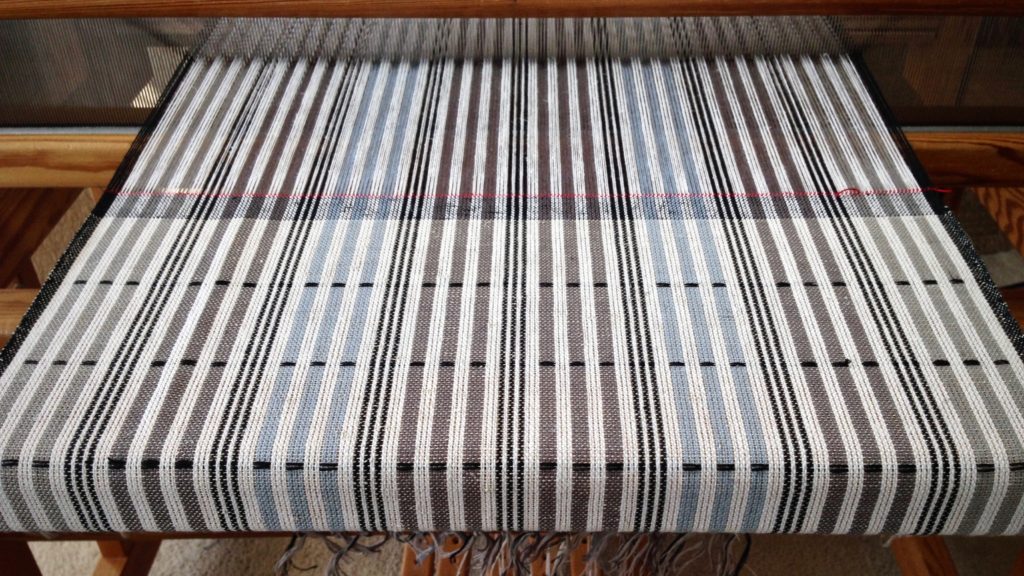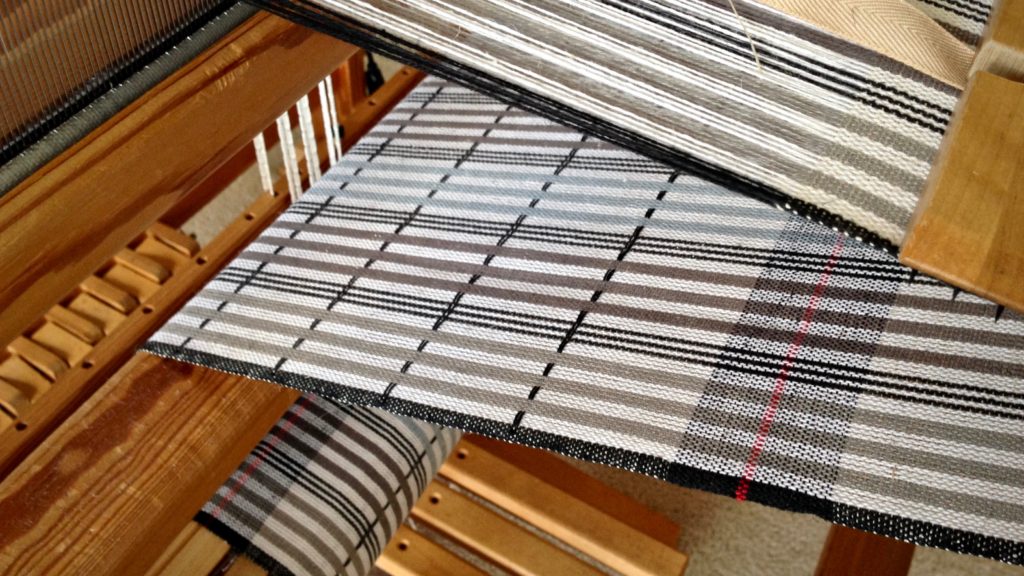Winding a warp like this is intricate work because of the frequent color changes. These narrow warp stripes provide the perfect canvas for plattväv accents. The simple weft float pattern, woven across the width every five centimeters, adds embroidered-like stitches to the cloth. Everything else is a breeze. It’s plain weave.

It’s good to have a plain weave project every now and then. It’s a reminder of how freeing it is to let the boat shuttle fly back and forth between your hands. Rag rug weaving isn’t like that. Soft alpaca scarf weaving isn’t like that. I’m zipping along, …only stopping to move the temple, advance the warp, and add the black linen accents. No worries here.

Consider all that has been prepared for us to have a meaningful life. Why should I worry? Who wound the intricate warp and put it on the loom? Doesn’t the Grand Weaver know what it takes to complete his design? We enter the Lord’s place of rest through the door of trust. True rest is worry free. Let the shuttle fly. Let the weft floats embellish the cloth. Come enter the place of rest.
May your worries slip away.
Plain weaving,
Karen

This is a lovely pattern. Could I do it on my RHL using pickup stick for the weft floats? Do you have a writtten pattern?
Hi Stephanie, It’s been so many years since I’ve done pickup on a rigid heddle loom. I don’t have a good answer for you, except I think it would work. The pattern is published in Kalasfina Vävar. Basically, the weft float goes under the white stripes and over the colored stripes (with the reverse on the the back side). It seems like you could easily do that pattern with a pickup stick.
If you try it, let me know how it works out!
Karen
Thank you so much for your reply. I am sure I can do something on the RHL
with the beautiful pattern and color way.
Thanks for the pictures and words that inspire us. I have a question – I’ve started using a temple more in the last few years of weaving and enjoy it. But when I look at my weft-wise stripes in a rag rug woven at high tension with my temple, the stripes at the end of the rug are still slightly curved or “smiling” at me, while the first few stripes are straight across. Do you have some wisdom on how to keep the stripes straight all the time? I’m advancing the temple about every inch.
Hi Lynette, The smiley face that comes about in the weft could be an indicator that you need to make the weft wrap more tightly around the selvedges. If you don’t keep the weft tight around the selvedges, the selvedge warp ends become looser than the rest of the warp ends. The temple actually helps with this because you can keep the selvedges tight without drawing in the whole weaving. Be sure to pull the weft very snugly around the outer warp ends to keep the selvedges from loosening up.
I hope that helps.
Karen
Can the plattvav accents be done as a loom controlled design feature on a 4 harness loom.
Are diagrams with English instructions available?
Thanks.
Louise
Hi Louise, Yes, the plattväv accents are loom controlled. This uses 4 shafts and 3 treadles. All the white ends are threaded on shafts 1 & 2, and all the colored ends are on shafts 3 & 4. Two treadles are for plain weave. The third treadle is connected to shafts 3 & 4 for the floats.
I have only found this in Swedish books, but the drafts are easy to understand. I use Google Translate to figure out words I need to know. 🙂
I’m thinking about making this project into a kit… Maybe some people would be interested?
Karen
Yes, I would be interested in a kit.
Tried using the coputer translator and came up with a possible alternative name for this weave?
munkabalte – swedish I think?
Is this weave like Monk’s Belt?
Louise
Louise, Yes, plattväv is similar to monksbelt (munkabalte). They both have the weft pattern floats. Monksbelt uses two blocks, and this plattväv has only one block.
Sounds like I need to do some kit planning.
Karen
Please keep us posted on the kit. Do you have other kits?
I will keep you posted. I don’t have any kits yet. This is a fresh idea I’ve been pondering. Thanks for your input!
Karen
I would love if you would produce a kit!!!
Hi Nancy, Thanks for letting me know! I’ll see what I can do. Thanks for your input!
Karen
Hi, Karen,
It has been a while. I went to Penland School of Crafts this summer on a work study scholarship. Wow! the staff was wonderful and the students so very talented. Many different areas of art were available for study. I got to study weaving. During the early 20’s the school was established to teach women and men how to weave. This developed a market resulting in a rise in the economy of the folks in the Smoky Mountains. Now the school has many different concentrations including photography, iron smith, concrete, jewelry, letter press, and ceramics to just name a few.
At PenlandI bought cotton-linen, 3/2 perle cotton and 100% bamboo fiber for warp. Most everyone said that it would not work and I should expect a waffle affect when finished. As we know every loom has its own personality. The loom I am using works best when the warp is very very tight. Which also worked well for the different weights of the warp I put on it. I separated the different colors and made stripes, and wove a left variation of a twill. A ribbon like design appeared where the smaller stripes occurred. I have yet to wash the piece, but no waffle shapes have appeared now that I have cut the 2 yards of fabric off the loom. How fortunate for me to see this article promoting stripes and your answer to Lynette question about the smiley sides of the salvages. I was trying to keep my salvages loose so as not to pull the warp in,but in doing so the salvages came up creating the weft higher at the edges. Now I know how and why that happened. Thanks for the insight.
My next projects will be a crackle weave table runners for my sibling’s Victorian homes. They have as requested that one will have a tomato soup red palette and the other has a peanut butter palette. Sounds like lunch to me.
Thank you Karen. In this crazy world we live in your words are both encouraging and soothing.
Pam, It sounds like you had a fantastic experience at Penland School of Crafts! Weaving provides a constant learning experience. I’m glad you were able to identify what was happening at your selvedges.
We all need encouragement from each other, don’t we?
Thanks for taking time to share your thoughts!
Karen
I definitely think a kit would be great!
Anne, That’s good to know! I am taking these suggestions seriously. I’ll keep you posted.
Thanks so much for your input!
Karen